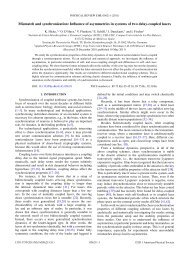DBI Analysis of Open String Bound States on Non-compact D-branes
DBI Analysis of Open String Bound States on Non-compact D-branes
DBI Analysis of Open String Bound States on Non-compact D-branes
Create successful ePaper yourself
Turn your PDF publications into a flip-book with our unique Google optimized e-Paper software.
CHAPTER 3. SUPERSTRINGS 40In D dimensi<strong>on</strong>s, and for D even, there are 2 ⌊D/2⌋ <str<strong>on</strong>g>of</str<strong>on</strong>g> them. 2 In two dimensi<strong>on</strong>s, <strong>on</strong>e canchoose a real, or Majorana, representati<strong>on</strong>, and we choose[ ][ ]ρ 0 0 −1=; ρ 1 0 1= . (3.4)1 01 0The spinors ψ µ also are real, and hence have two (real) comp<strong>on</strong>ents, which, in anticipati<strong>on</strong><str<strong>on</strong>g>of</str<strong>on</strong>g> the use <str<strong>on</strong>g>of</str<strong>on</strong>g> light-c<strong>on</strong>e coordinates, we denote[ψ µ ψµ]−=ψ µ . (3.5)+We further define¯ψ = ψ † β ; β = iρ 0 . (3.6)Note that since ψ µ is real, ψ † = ψ T . It should further be pointed out that the fields ψ µanticommute, as they are expected to, so{ψ µ , ψ ν } = 0. (3.7)This is <strong>on</strong>ly true in the classical theory though. Although we will not go into this, wementi<strong>on</strong> that quantum mechanically this relati<strong>on</strong> gets upgraded to{ψµA (σ, ( τ),ψν B σ ′ , τ )} = πη µν δ AB δ ( σ − σ ′) . (3.8)We see that at first sight, we are c<strong>on</strong>fr<strong>on</strong>ted with the same ghost problem we had for thebos<strong>on</strong>ic string. In order to eliminate these, <strong>on</strong>e has to introduce supersymmetry, whichresults in an extensi<strong>on</strong> <str<strong>on</strong>g>of</str<strong>on</strong>g> the Virasoro algebra (called the super-Virasoro algebra), inturn leading to altered super-Virasoro c<strong>on</strong>straint equati<strong>on</strong>s, which will do the trick.For the sake <str<strong>on</strong>g>of</str<strong>on</strong>g> completeness, we menti<strong>on</strong> that while we introduced, or even imposed,supersymmetry by hand, <strong>on</strong>e could also define a superspace, which amounts to addinganticommuting coordinates to an arbitrary space-time. The advantage <str<strong>on</strong>g>of</str<strong>on</strong>g> this is that inthis formulati<strong>on</strong> supersymmetry if manifest. For our purposes however, this does notmake any difference for the results we want to obtain, and would <strong>on</strong>ly needlessly makethings more complicated. Interested parties are referred to e.g. [9], §4.1.2.3.2 Equati<strong>on</strong>s <str<strong>on</strong>g>of</str<strong>on</strong>g> moti<strong>on</strong>We first <str<strong>on</strong>g>of</str<strong>on</strong>g> all note that the bos<strong>on</strong>ic term in the string acti<strong>on</strong> is unaffected by thepresence <str<strong>on</strong>g>of</str<strong>on</strong>g> the fermi<strong>on</strong>ic term. Hence, nothing will change in the equati<strong>on</strong>s <str<strong>on</strong>g>of</str<strong>on</strong>g> moti<strong>on</strong>,and subsequent spectrum <str<strong>on</strong>g>of</str<strong>on</strong>g> the bos<strong>on</strong>ic part <str<strong>on</strong>g>of</str<strong>on</strong>g> the string. This allows us to single outthe fermi<strong>on</strong>ic part <str<strong>on</strong>g>of</str<strong>on</strong>g> the equati<strong>on</strong>, and c<strong>on</strong>sider it separately. Let us denote this partbyS F = − 1 ∫2πα ′ d 2 σ ( ¯ψµ ρ α )∂ α ψ µ . (3.9)2 For D uneven there is <strong>on</strong>e more, but we will not be c<strong>on</strong>fr<strong>on</strong>ted with this possibility.
















